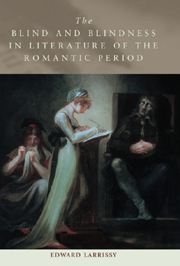Book contents
- Frontmatter
- Contents
- Preface
- Acknowledgements
- 1 The Enigma of the Blind
- 2 The Celtic Bard in Ireland and Britain: Blindness and Second Sight
- 3 Blake: Removing the Curse by Printing for the Blind
- 4 Edifying Tales
- 5 Wordsworth's Transitions
- 6 Coleridge, Keats and a Full Perception
- 7 Byron and Shelley: The Blindness of Reason
- 8 Mary Shelley: Blind Fathers and the Magnetic Globe: Frankenstein with Valperga and The Last Man
- 9 Conclusion
- Bibliography
- Index
2 - The Celtic Bard in Ireland and Britain: Blindness and Second Sight
Published online by Cambridge University Press: 12 September 2012
- Frontmatter
- Contents
- Preface
- Acknowledgements
- 1 The Enigma of the Blind
- 2 The Celtic Bard in Ireland and Britain: Blindness and Second Sight
- 3 Blake: Removing the Curse by Printing for the Blind
- 4 Edifying Tales
- 5 Wordsworth's Transitions
- 6 Coleridge, Keats and a Full Perception
- 7 Byron and Shelley: The Blindness of Reason
- 8 Mary Shelley: Blind Fathers and the Magnetic Globe: Frankenstein with Valperga and The Last Man
- 9 Conclusion
- Bibliography
- Index
Summary
Physical blindness and ‘second sight’ could, from the early eighteenth century, be associated with the Celtic bard and thus become markers, in polite literature, of a prophetic or poetic vision supposedly common in Celtic countries. Ossian, of course, was blind – like Homer, as it is customary to note – and was clearly possessed of ‘second sight’. So that, given the ascendancy Macpherson's imitations exerted over the thoughts and ambitions of the poets and poetasters of two continents, one might ask if it is really necessary to do more than lay the association at his door. Yet, as we shall see, the association precedes the appearance of Ossian, and even subsequently is not bounded by reference to Ossian. When they occur in Romantic writing, the topics of blindness and second sight are closely linked with the development and the definition of the central Romantic ideology of poetic vision, so it is surely worthwhile to be clear and discriminating when assigning sources to their characteristic imagery.
The Blind Harper in Ireland and Scotland
Richard Stanihurst (1547–1618), one of the ‘old English’ in Ireland, had first introduced the notion of the blind harper to non-Irish readers in his De Rebus in Hibernia Gestis (‘On the History of Ireland’, 1584). As Edward MacLysaght points out, this was accepted as one of ‘the standard books on Ireland for nearly two hundred years’. Describing the customs of the Gaelic nobility, Stanihurst observed that, ‘During supper there is present a harpist, often blind, who relaxes the reclining guests by striking his strings […]’.
- Type
- Chapter
- Information
- Publisher: Edinburgh University PressPrint publication year: 2007



